It’s finally starting to feel like spring, and I couldn’t be more grateful. It’s so much easier to motivate myself to work when the sun is shining, especially after months and months of frigid winds and gray skies. March is always an odd month, sitting right at the edge of winter and spring, and it often makes me feel unsettled.
After over a month since my sweet kitty Mia’s passing, my husband and I decided we would start the process of looking for new feline companions, specifically hoping to adopt a bonded pair. We absolutely did not expect to adopt on the day we went to the local MSPCA shelter, but of course…the cats had other plans. On March 17th (Saint Gertrude’s Day, the patron saint of cats!), we brought home Zelda and Hilda, a mother-daughter pair of little black cats. They are charming in the extreme, so expect me to gush about them even more as time passes.
On the other end of the spectrum, I’m going to be having my wisdom teeth removed this coming Friday. It’s long overdue, and I’ll be glad once it’s done, but I’m definitely dreading what I’ve heard is a rather painful healing process. But who knows, maybe it’ll afford me more time to read….
Which brings me to the point of this post! Last month I did a round up of my favorite comics reads, and I’m going to go for it again. If I do it twice, it’s a monthly column, right? I actually didn’t read a ton of comics this month, instead favoring some truly indulgent murder mystery audiobooks. But of what I did read, there are a few certain gems that I want to share.
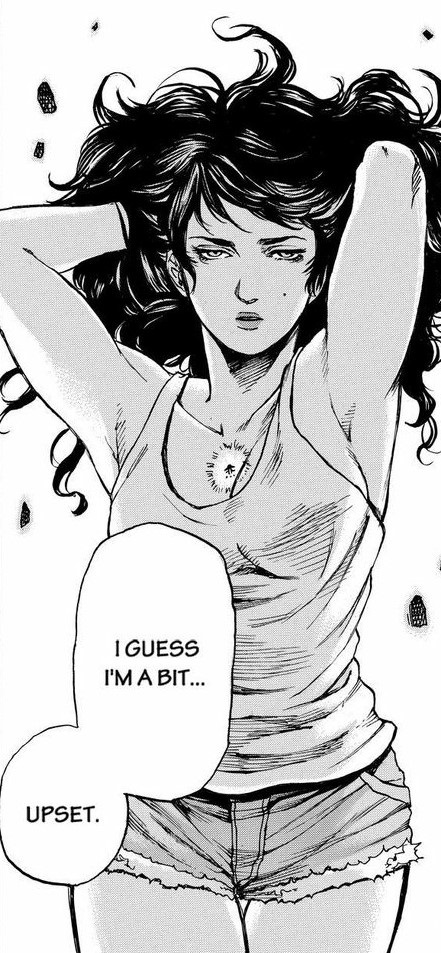
Star Light Woman, by Rie Kanou — available through Crunchyroll
At the start of the month, I decided to sift through the various reading-oriented apps on my tablet to find something new, and I came upon Star Light Woman on Crunchyroll. I was drawn by the image of protagonist Hoshi, rendered in what I think of as an 80s manga style, all puffy hair and cut-off shorts. I’m not sure what I was expecting — maybe a silly, slightly sexy sci-fi romp? And that’s more or less what it is, but somehow I really, really loved it. Hoshi just wants to lead a normal life, but she is the product of an experiment by an alien race to create the perfect weapon to save them from their enemies. She continually has to thwart these aliens while encountering other humans who have undergone similar transformations at their hands. It’s a short little series without much depth, but it’s truly funny and the artwork is stunning. I’m usually very critical of “sexy lady protagonist whose clothes don’t fit properly,” but Hoshi even gets my blood pumping, and I think that her strong, solid frame coupled with her highly moral principles lends a lot to her appeal. She’s like an embodiment of righteous female anger — a subject I’m always eager to see in my fiction!

Memoirs of Amorous Gentlemen, by Moyoco Anno — available through Crunchyroll
I love Moyoco Anno’s work, though I have to admit that this was only the second thing of hers I had ever read. Sakuran was a gorgeous and deeply provocative manga, so when I was scrolling through options on Crunchyroll’s manga app after finishing Star Light Woman, I remembered that I had been meaning to read Memoirs of Amorous Gentlemen for quite some time. I was not at all disappointed, and in fact I read Buffalo 5 Gals immediately afterward, just to get more of Anno’s sassy sex working heroines. But Amorous Gentlemen is special, probably my favorite of Anno’s works thus far. She is incredibly sensitive with sex work while also not over-glamorizing it; Colette and all her co-workers go about their day-to-day business like at any other job, and in many cases care very deeply about their clients. But they also are in close quarters, so they fight and disagree, and sometimes they are all too aware of how they are doomed to this life. The sex scenes are sometimes clinical and sometimes genuinely sexy, and I think that knowing when to evoke which mood in a reader is an incredible skill on Anno’s part. I’m also always going to be a sucker for her very stylized artwork, all angles and frills and fashion.
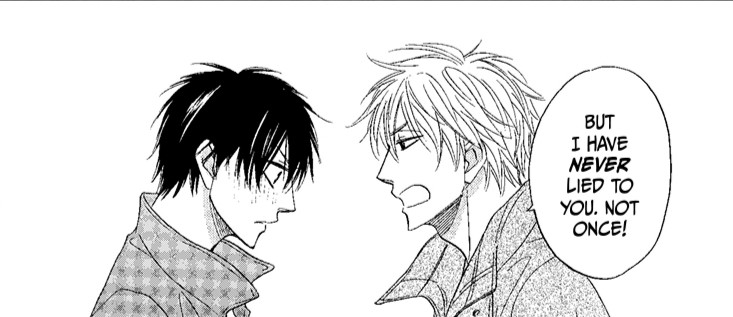
Candy Color Paradox, Volume 1, by Isaku Natsume — published by VIZ Media
The only manga on this month’s list that’s actually new this month, and the only one that has male protagonists! I was able to snag a galley copy of this right before it came out, and I honestly didn’t think it would be anything special. I’ll usually try to read new BL when it comes out, but I’ve been burned so many times with cliched plots or harmful tropes that it’s more a desire to keep up-to-date than an expectation that I’ll find something great. But VIZ’s SuBLime imprint has been knocking it out of the park lately, and I really liked this first volume. Protagonist Satoshi Onoe is a reporter who is proud of his body of work, but one day he is thrown onto a stakeout team with Motoharu Kaburagi, a photographer with a bad attitude whom Onoe believes stole his girlfriend away. The two start off on rough terms, but soon find that they work well together — and they begin to “catch feelings.” You know, that old gem. Honestly, it was cute and fluffy, and I feel like it’s been a long time since I read some straightforward “loathe to like to love” BL manga. The artwork is clean and appealing, with good sense of movement.

Nana, by Ai Yazawa — published by VIZ Media
This month, I decided to embark on a reread of Nana, and I’ve gotten up through volume 7 so far. I honestly don’t remember how much if it I’ve read in the past, so I wanted to make sure I got the full experience. I had watched the anime with my husband many years ago, and it wrecked us both, so coming back to it now, as a woman approaching my thirties instead of a woman barely out of her early 20s, is kind of a weird sensation. I’m farther away from any chance of making rash young adult decisions, but also in a place where I can envy the energy and passion that the characters portray as they lead a dramatic, punk-poverty-chic lifestyle. The series is old now, at least in the timeline of manga, so I don’t feel the need to summarize it, though I may one day write a whole piece about its meaningfulness to me, personally. I remember it didn’t sell great at Comicopia, but it was one of those series that I was adamant about keeping around. Yazawa’s artwork is so strange, with leggy, large-eyed Blythe-doll-esque characters and gorgeous renderings of haute couture of the 2000s, and I’m always enthralled by it. And I genuinely wish there was more work like Nana, work that explored the fraught relationships between female friends who love each other so passionately but don’t have the outlet to express it — an experience that will surely be familiar to many who squashed down their feelings throughout their teenage years for fear of judgment, or just because they didn’t have the tools to recognize those feelings. Society fucks women over, and Yazawa does an incredible job of balancing that message with a lot of genuine sensitivity for two very different women who are desperately reaching for an unobtainable happiness.
So, fluffy BL aside, it seems like I’ve read a bunch of manga about women who are dealing with too many external pressures getting in the way of their desires. That sounds like an appropriate way to have spent Women’s History Month! Honestly, though, my favorite works are often those by women representing the trials of womanhood — not because womanhood is terrible! But because it is cathartic to see your own worries magnified and projected in media sometimes, to see those fears getting played out somewhere safe, allowing you to recognize their validity but also release them in order to achieve your own goals, always knowing that you’re not alone.

recommendations
The Beautiful & the Damned; Where Violence Meets Aesthetics in Pet Shop of Horrors
Among the extensive list of things I shamelessly love are: the occult detective genre, beautiful men, the monster-of-the-week format, and morality plays. Matsuri Akino’s Pet Shop of Horrors very neatly contains all of these things, and indeed might be the reason I’m so fond of some of them.
For those unfamiliar with this late-90s shojo series, the premise is that in LA’s Chinatown there is a mysterious pet shop whose proprietor, Count D, sells exotic “animals” to anyone who can pay the price. Each animal comes with a specific set of rules, and when those rules aren’t followed to the letter, tragedy inevitably occurs. LAPD officer Leon Orcot is assigned to investigate D and the weird phenomena linked to his shop, but in the process he is drawn into a series of Twilight Zone-esque situations that he cannot explain, let alone report to his superiors.
Right now, I can look at this premise and think to myself, “Yep, this is totally my kind of bullshit.” But when I first picked it up as a young teen, it was because I was drawn to its beautiful cover, where the androgynous D is holding a mermaid, whose back is turned to the viewer. D’s eyes are piercing and almost sad, his fingers long and delicate. I was in love with this man who moved in multiple worlds: the masculine and the feminine, reality and fantasy, beauty and horror.
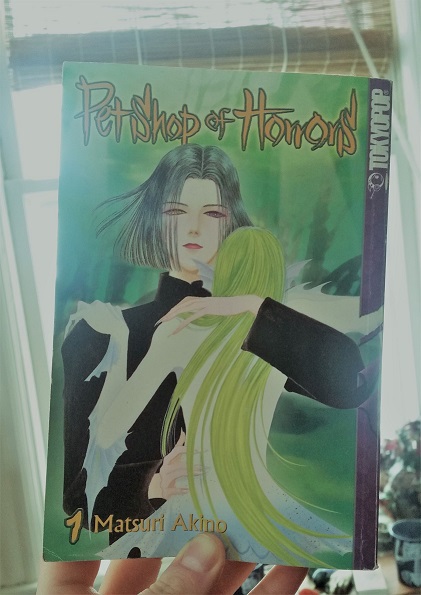
And when I bought and read this first volume, I was shocked. It wasn’t outright scary, necessarily, but it certainly was gory. In the first chapter already was there a horrific scene of evisceration, in and amongst all the trappings of a classic 90s shojo style, preoccupied with luxury and beauty. It was jarring, and it was effective. I discovered then that I didn’t dislike horror like I had previously thought, I just wanted it to be beautiful.
To this day, I find myself critical of scary or violent media that doesn’t also have a keen sense of aesthetics. I don’t necessarily enjoy being frightened; I am a naturally anxious person with vivid and violent dreams who does not react well to heightened suspense in media. I do like dark themes, though, and in recent years I have made it a point to expose myself to films especially that I know I would like if I could just get over my own hang-ups. And by being discerning, I’ve been rewarded with some of the most gorgeous horror and gore I’ve ever seen.
I think beauty and romance are natural companions to horror. All these themes pivot on an axis of drama, of amplified emotions. They all invoke visceral reactions, not logical ones. All my life I’ve surrounded myself with artwork depicting scenes and themes of witchcraft, hauntings, murders, martyrs, and mortality. It seems natural to me that scary things can pull at the same emotions I feel when I recognize something as beautiful.
And all this because way back in 2003, Tokyopop decided to take a chance on something that wasn’t very common in the comics world at the time: horror for girls. There’s plenty of it to be found in the manga world, and now there is more acknowledgement of girls and women reading outside of the romance genre. But it was new for me then, and even now Pet Shop of Horrors remains one of my favorite series, because it presented to me something I hadn’t known I was seeking out. It understood my tastes uniquely; it was able to marry my desire with my rage and prove them to be not disparate but intertwined and equally valid.
In truth, it is a somewhat silly series. It is certainly more fun than profound, but that in and of itself is not a criticism. It is pure, indulgent entertainment, and for me it is certainly laced with a nostalgic love that I will never be able to shake. How many times have I reread and referenced that first volume, gazing awestruck at the lovingly rendered intestines spilling out of a beautiful man’s body? How many times have I giggled at the flirtatious relationship between D and Orcot? How many times have I wished that modern depictions of mermaids were even half as scary as the one Akino has created?
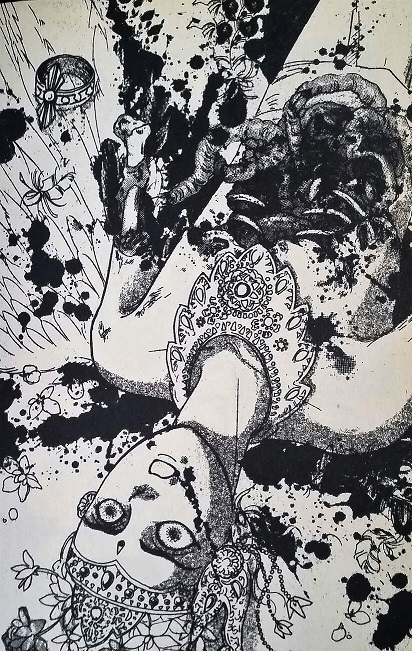
The series is unfortunately long out of print, and later volumes are hard to find. I imagine that it wasn’t a huge seller for Tokyopop, though I am forever grateful that they took a chance on it to begin with. The anime is available to stream on HiDive, brief as it is, if you’d like to get a glimpse into Count D’s enigmatic Chinatown pet shop.
February Favorites
Time for something new! I’m going to start trying to round up some of my favorite comic reads at the end of each month. These won’t necessarily be things that came out the month in question (though I do try to keep up when I can), but anything I’ve managed to get my hands on that I feel is worth a mention. I read a lot, so I’m going to have to figure out how to limit my choices, but hopefully with time will come clarity!
I will say, first off, that this has been an…interesting month. I still feel so new to the freelance writing world, but I do think that things are coming together nicely, and I’m getting to a point where I can start challenging myself with how much work I take on. I also lost my cat, Mia, on February 12th. She was quite old, and her decline was very rapid. While she was sick, I spent a good deal of my time attending to her; after her death, there was a lot of time where I was just too miserable to feel like I wanted to do much of anything, let alone read. Still, a visit to Comicopia did help lift my spirits considerably, and while I have to be a little bit more judicious in my purchases right now, I was able to bring home some good new material.
I am also about to spend five days with my family while James is away on business, which is why I’m getting this out before the true end of the month. I suspect I will be too busy doing things with my mom and trying to keep up with my writing work to read too many more comics. But I wanted to give this segment a try, anyway, so I’ve decided to work with what I’ve got.
So without further ado, my picks for the month!
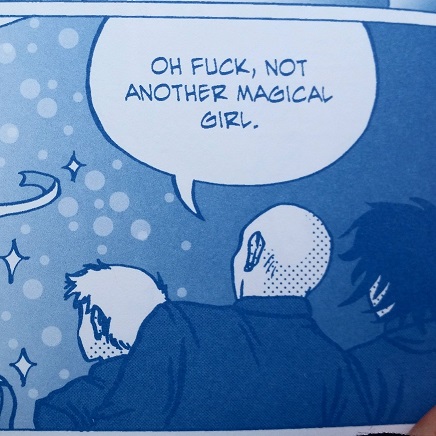
Magical Beatdown, Volume 1, by Jenn Woodall — published by Silver Sprocket
This slim little issue does one of my favorite things: It combines a love of the ultra-femme concept of the magical girl and mixes it generously with a hyper-violence that is both gross and cathartic at the same time. I think there’s a lot to be said about women enjoying and creating violent content, and some day I hope to talk about it more in-depth. But for now, I want to recommend the excellent pastel gore-fest revenge fantasy that is Magical Beatdown, because sometimes you just wanna go to the arcade without having to deal with losers! I’m looking forward to getting my hands on the second installment.

House of Penance, by Peter J. Tomasi, Ian Bertram, and Dave Stewart — published by Dark Horse Comics
Speaking of gore-fests, this standalone graphic novel is not for the faint of heart or stomach. The Winchester mansion in San Jose, California, is famous for it’s staircases that lead to nowhere, its doors that open onto nothing but air, and the nagging suspicion that it is not entirely empty. House of Penance is an exploration of Sarah Winchester’s mental state as she commissions the building of this strange domicile while grappling with the grief of losing her daughter and her husband, and the guilt of inheriting the wealth from a company whose business is murder. I’m always down for a strong anti-gun message, personally, and there is no holding back here as Sarah is confronted relentlessly by the victims of her in-laws’ firearm empire. Ian Bertram’s art is eerie and textured, Sarah especially portrayed with bug-like eyes that can see more than the men working around her. Dave Stewart’s incredible colors compliment Bertram’s lines beautifully, and his use of bright, vibrant blood red is very effective.
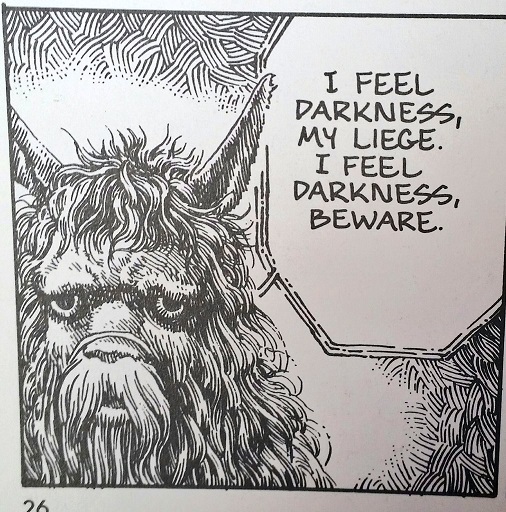
Shion: Blade of the Minstrel, by Yu Kinutani — published by VIZ Media (out of print)
I came upon this volume completely by accident, while I was still working at Comicopia. It was hidden away in storage, in a long box full of old single issue comics, many of which were single issue manga, from way back when everything was flipped and companies tried selling manga like Western single-issue comics. I was drawn to its striking cover and detailed artwork, so I brought it home. That had to have been nearly two years ago, as I had put it into a comic box and promptly forgotten it. I dug it out recently while I was doing some organizing, and I resolved to finally read it.
And honestly, I was stunned. This little volume is so extraordinarily different from any manga that is being licensed and published today. It wouldn’t be seen as marketable, probably, but I’m so glad that VIZ took a chance on it back in 1991, because it was a pleasure to read. The book is split into two stories that follow a mysterious minstrel who must first take his revenge on a monster who wronged him and his family, and then must take up a legendary sword to fulfill his destiny. That one sentence seems like straightforward fantasy, and in many ways that’s what Shion is; as an essay at the back of the volume explains, it is a classic hero arc seen in many fairy tales and epics. But it’s so gorgeously textured in its artwork, and for me it invoked the same feelings as Vampire Hunter D and classic Jim Henson works, especially The Dark Crystal. It’s creative and beautiful, and I’d love to see what Kinutani did after this work. Worth hunting down if you are able!

My Solo Exchange Diary, Volume 2, by Nagata Kabi — published by Seven Seas Entertainment
In many ways, there’s not much I can say that I haven’t said before, in various spaces, about Nagata Kabi’s autobiographical work. Of the three volumes she has out from Seven Seas right now, I think this one was my favorite, even though much of it was spent talking about her time in the hospital. I appreciate, more than ever, her honesty, especially as she realizes how her mental state had prevented her from understanding how much her family actually loves her and wants what’s best for her. She continues to struggle throughout the volume, but it is evident that she’s repairing her relationships and learning, slowly, how to better communicate her pain so that she’s not suffering alone. I know that many people have been critical of her constant self-destruction, but to that end I just have to say…it is evident those people have never struggled with serious mental illness, or really known anyone who has. What Kabi is going through is not logical, it is not easily navigated, and her honesty and willingness to expose herself like she this has surely had a positive effect on others who have felt similarly isolated, self-destructive, and hurt. I continue to send her only the kindest, gentlest, most positive thoughts as she works on overcoming her pain. It’s a hard road, and she’s been working at it for a long, long time. I hope she’s able to find some peace soon.
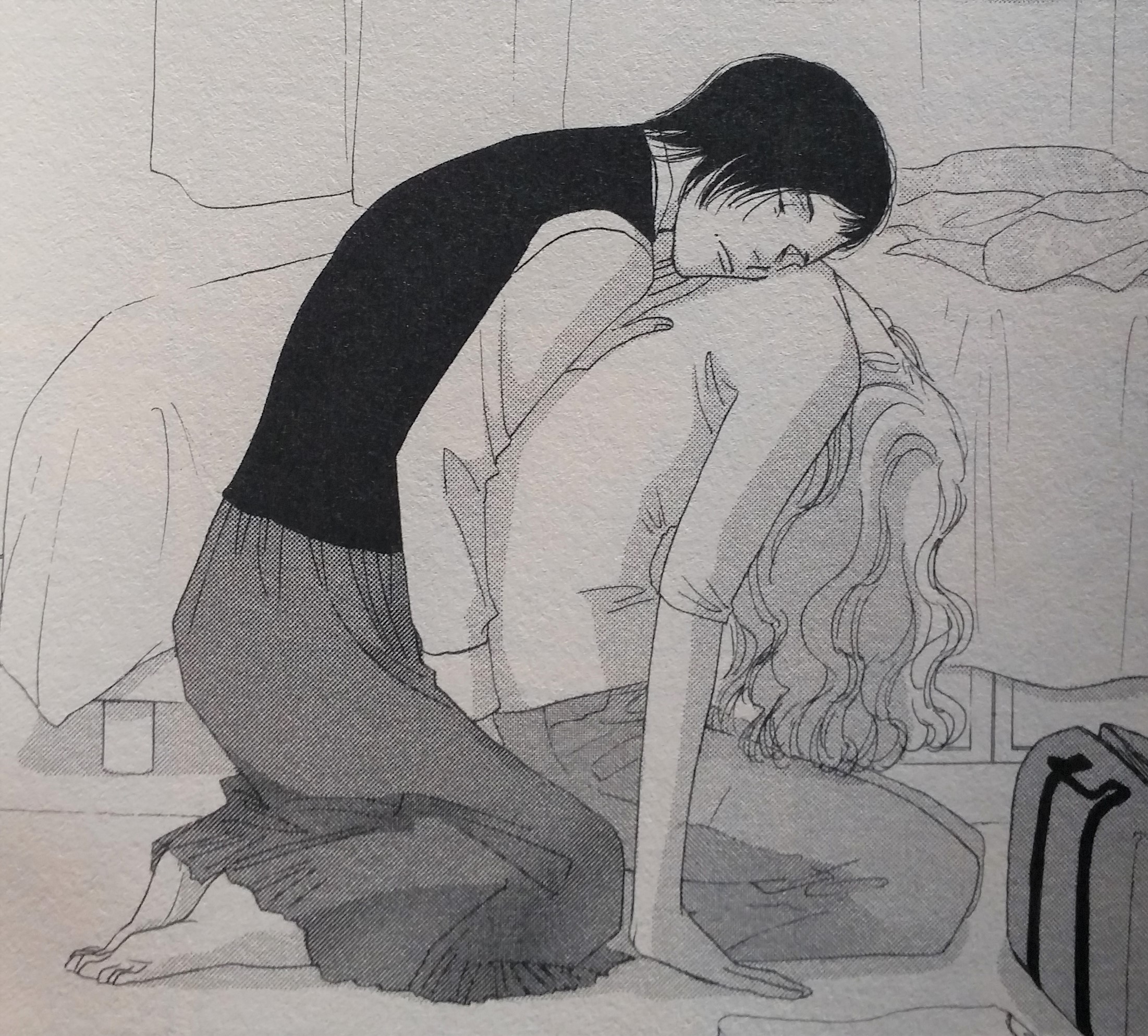
All My Darling Daughters, by Fumi Yoshinaga — published by VIZ Media
Fumi Yoshinaga is one of those creators whose work I always know I’ll enjoy, but who also manages to completely exceed my expectations every single time. So was the case with All My Darling Daughters, a standalone volume that explores various relationships between people in a friend group, with special emphasis on the one between Yukiko and her mother, Mari, who has married a much younger man. Yoshinaga has such a sensitive touch with her characters that I find myself sympathizing even with those who in a different author’s hands, I would absolutely hate. It is an incredible skill to express the nuances of humanity, and Yoshinaga is extraordinarily good at it. I felt especially drawn to the last story in the collection, which dives into Mari’s antagonistic relationship with her own mother (Yukiko’s grandmother). Mari hates her mother for having been unnecessarily cruel about her appearance while she was growing up, not realizing that her mother was trying, in her own imperfect way, to protect her daughter from becoming reliant on her good looks. I was so strongly reminded of the dynamics between the women in my own family, the dynamics between my mother and my grandmother, and the increased awareness I have lately of how heavy motherhood can be. “A mother is an imperfect woman,” Yukiko realizes, and it is a perfect underscore to a book full of imperfect people who are just trying to do the right thing.
Looking back, it seems I’ve read a lot of very different books this month, but there are certain themes that run throughout. A lot of introspection, explorations of mental health (both real and fictional), and a little bit of violence and some adventure to balance things out. I like the micro-review format because I can fit several recommendations into a post at once, and I am not liable to give too much away. I hope this proves useful, and I look forward to following up again next month with some more excellent reads!
My Favorite Reads of 2018
It’s that time of year again, where every single nerd news site tells you what the best-of-the-best comics of the year are. I’m always wary of trying to make blanket statements about literature, but I did want to share a few of my favorites from this past year. I’ve done a LOT of reading, and I feel as though I’ve branched out more than usual (or more like, there have been more titles in Western comics that have appealed to me than there have been in the past).
I didn’t give myself a limit to the number of books I chose, nor any kind of guideline as to theme, tone, etc. I just picked the ones I felt strongly about! These are listed in roughly the order I read them in, and by no means in order of quality. They’re all top-notch, anyway!
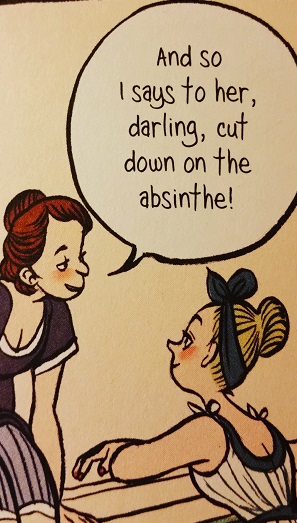
The Prince and the Dressmaker, by Jen Wang
Prince Sebastian has a BIG secret: sometimes he likes to wear dresses and go out on the town as Lady Crystallia. In addition to keeping this part of himself hidden from Parisian society, he has to deal with his parents determinedly seeking out a bride for him. Enter Frances, an extremely skilled seamstress with dreams of fashion design whom Sebastian employs to outfit him for all occasions, public and secret. The story of these two growing together and learning to be their best selves is captured incredibly in Wang’s bright, flowing artwork. Plenty of humor helps to balance out the heart-rending moments that remind the reader to never lose sight of the things that make them unique.
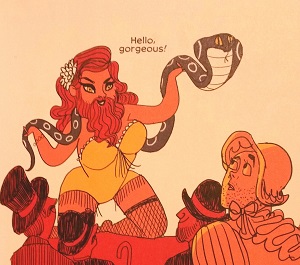
Brazen: Rebel Ladies Who Rocked the World, by Pénélope Bagieu
I genuinely did not expect to adore this book as much as I do. I’m not well-versed in the non-fiction graphic novel, and I’m often suspicious of cheery, pink-emblazoned “girl power” books — not because I don’t believe in girl power, but because it’s hard to encapsulate in one book what it is about womanhood that is so unique. That said, I was truly fascinated and enthralled by the stories that Bagieu, in her whimsical style, has presented in this hefty tome of awesome and awe-inspiring women. Women from all backgrounds, in all types of careers, with differing needs and goals, and with all sorts of romantic entanglements and personal dramas, are presented for the reader with reverence, joy, and good humor.
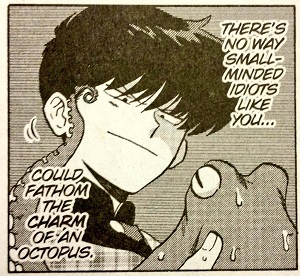
Go For It, Nakamura!, by Syundei
I have been seriously reveling in the increased publication of good, sweet, not-super-fetishistic BL manga this past year or so. In this exquisite example, young Nakamura knows for sure that he’s gay, and also knows for sure that he’s in love with his classmate, Hirose. The problem is, he doesn’t even know how to become friends with Hirose, never mind try to ask him out! Between caring for his pet octopus, perusing questionable BL for romance tips, and just generally trying not to act overly weird, will our stalwart hero ever secure Hirose’s friendship? A familiar story for anyone who was shy in high school, Go For It, Nakamura! uses awkwardness, hilarity, and genuine heart to create a sweet and fuzzy one-shot that will make you yearn for more. Syundei’s artwork is adorable, and very reminiscent of that of manga powerhouse Rumiko Takahashi.
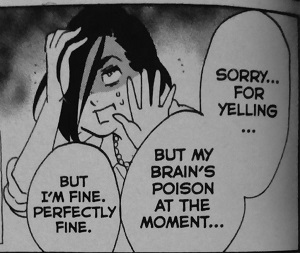
Tokyo Tarareba Girls, by Akiko Higashimura
I wrote about my initial reaction to volume one of Akiko Higashimura’s forays into 30-something woman angst back when the print version first came out. The series is now three print volumes in (with all volumes available digitally), and it has not stopped being maybe the most anticipated title in my pull at work. Higashimura’s ability to poke fun at the stupidity of a woman’s society-bred anxieties while treating the same character with sympathy and understanding is so incredible to me. I often find it hard to articulate what it is that makes this series so good, because it’s really everything. Please…I don’t often make demands, but read Tokyo Tarareba Girls.
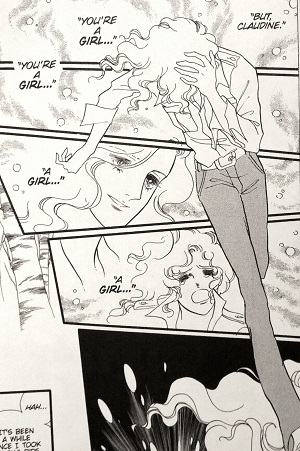
Claudine, by Riyoko Ikeda
I find this manga hard to recommend, even though I love it. It is a quick read; I read it from start to finish on my half-hour bus ride home from work one day. But it is also a dramatic and sad read, in true 70s shojo fashion. Our protagonist Claudine is assigned female at birth, but knows in his heart that he is a man. Even his own father embraces Claudine as more of a son than a daughter, going riding with him and treating him like his older brothers. Society in early 20th century France, however, is not as kind. To the rest of the world, Claudine is a girl, and the tragedy here lies in the outmoded concept that any woman he might love will never lead a fulfilled life with a “woman” partner. So in many ways, this is a fantastic achievement, being a trans story from 70s Japan; but it is also a story about a trans man from the perspective of a cisgender woman, writing at a time when shojo manga was about deep, dramatic personal struggles and utilizing queerness as a vehicle for those struggles. If you can go into it with the understanding that it is a sad story (and yes, I did cry on that fateful bus ride home), it is a simply gorgeous and heartbreaking work of tragedy.
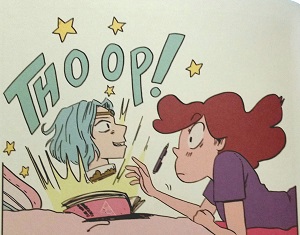
Making Friends, by Kristen Gudsnuk
I’ve been in love with Kristen Gudsnuk’s work ever since I read the first issue of Henchgirl, back when it was released by Scout Comics. Her artwork is fun, her dialogue is funny, and she makes plenty of obvious anime references that I feel are speaking directly to me and my sense of humor. So of course I was thrilled when Making Friends came out, and I was not disappointed. Protagonist Dany is starting middle school, where she is separated from her friends and everything that was familiar to her. She turns inward and begins to draw in the sketchbook she recently inherited from her recently deceased great-aunt. Soon she discovers that anything she draws in the sketchbook — including the head of her favorite anime badboy — comes to life! She quickly devises a plan to create a new, perfect best friend. But as we all know, magic has serious consequences, and Dany is going to have to figure out how to fix the mess she’s made. Gudsnuk does an excellent job of keeping this story about friendship and responsibility from becoming saccharine or tropey, instead treating every character with equal weight and relying on her uncanny knack for coming at a story from a slightly sideways perspective.
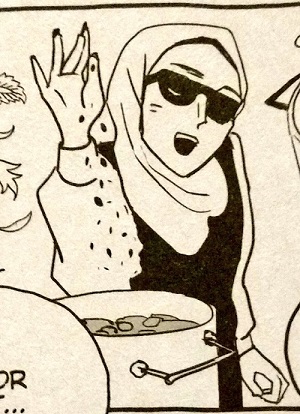
Satoko and Nada, by Yupechika and Marie Nishimori
This was absolutely one of my most anticipated titles of the year, and man oh man did it hit a home run for me. Upon initially receiving it I was uncertain, as it is laid out in 4-koma format, which I usually find cute but not particularly compelling. And yet in this easy gag style, with simple illustrations, Satoko and Nada manages to be a profoundly intimate story of friendship between women and across cultures. Nada is a college student from Saudi Arabia who is looking for a roommate. Satoko, a student in the same school, has recently arrived from Japan and chooses to become that needed roommate. Thus begins this tale of two people from very different backgrounds as they live together and learn all about each other and about their multicultural friends. Warm-hearted, informative, and full of meme references, this manga really surprised me in the best possible way. I want everyone to read it!
(Just an honorable mention here: I reread two of my absolute favorite series this year: Pet Shop of Horrors, by Matsuri Akino, and The Wallflower, by Tomoko Hayakawa. One day, I’d like to write at length about both of these series, but as they’re old and hard to find, I opted against adding them to this list. Look forward to an analysis of them one day, because I am very attached to them both!)
As you can see, I read a lot of very heartwarming stories by or about women this year. I have been immensely impressed by the range in stories and creators I’ve had access to, and that’s something I want to see continue to grow year by year. My reading list has been a bright spot in what has been a very tumultuous year otherwise (personally and in the world at large), and it gives me hope that more differing voices are being tapped to tell more and varied stories.
Looking forward to reading more in 2019!
Monthly Manga Mailing
I have some exciting news to share with everyone today! Part of my job is to advise fellow comics retailers on which manga they might be interested in stocking in their stores. Because the demand for this service has gotten so high and is causing me to cross-post in several groups, I’ve decided to create a mailing list! While it will be geared toward comic shop retailers, certainly anyone who would like to see my monthly thoughts on upcoming titles is welcome to sign up. I just ask that everyone bear with me as I slowly learn how to use MailChimp to its fullest potential, haha. The link to sign up is here, and I’ll be posting it in several locations over the course of today so that it reaches everyone who might want it!
In other news, I haven’t written much lately, but I assure you all that I’ve been reading a ton. I’ve been on a bit of a shojo romcom kick lately; I read seven volumes of Waiting For Spring the other day, and have slowly been working my way through High School Debut. I’m not sure why, but every now and then I just feel the need to read something sweet and positive, and shojo romances really fill that requirement for me.
My last post was a review of a middle reader graphic novel that isn’t a manga. This doesn’t mean I’ve abandoned manga (obviously), but I do want to mention that I probably will be doing more non-manga reviews in the future. I believe that middle reader and young adult graphic novels are among the best (and best-selling) graphic works right now, and I would be remiss if I didn’t mention them, especially as so many of them have been influenced by manga and are being read alongside manga. Media, after all, does not exist in a bubble. Works for young audiences are important right now, creating many new readers and strengthening visual literacy.
And that’s all to report right now! Just some little updates to tide you over until I post again — or until you sign up for my regular emails!
Ghosts & Grief: A Sheets Review
I’m a sucker for friendly ghost stories. As a kid, I was desperate to meet a ghost, dragging my best friend through her 300+ year-old house with a tape recorder ready to catch some EVP or find cold spots. I was also raised by my single mother and my tailor grandparents — so Brenna Thummler’s new middle reader graphic novel, Sheets, speaks to me on many levels.

Marjorie Glatt has recently lost her mother, and with her father overwhelmed by grief and depression, she is left to manage the family’s laundromat all on her own. Between that, her school obligations, her little brother, and their overbearing neighbor Mr. Saubertuck, Marjorie feels overwhelmed and adrift. Similarly adrift, a ghost named Wendell wanders into the Glatt Laundromat after his escape from the Land of Ghosts. Prone to mischief, Wendell turns the laundromat upside down one night, hardly endearing himself to Marjorie, who very much does not believe in ghosts. But with Mr. Saubertuck putting the pressure on Marjorie to give up her family’s land in order for him to build his new spa, Wendell and his fellow ghosts might be her only hope of keeping the business…afloat.
It is no secret that being a young teen is difficult; the chaos and uncertainty of puberty are exacerbated when a child is thrown into a tragedy like the death of a parent, or a divorce, or a debilitating illness. But while we try to shield our children from the harm of the world, we cannot prevent every bad thing from occurring. I sometimes hear complaints about media that depict untrustworthy adults, but the reality is that there are plenty of adults — even ones who mean well — who are not always up to the task of making things work so that their children don’t have to suffer. Sheets portrays that relationship well, with Marjorie’s father very clearly caring about his children only as far as his depression will allow; and those who have ever suffered from depression, whether chronic or episodic, will relate to the empty numbness that Mr. Glatt experiences.
Despite the heavy material, this book is not a downer! Thummler’s artwork conjures up the wonder of childhood autumns, each page reminiscent of faded photo memories. The action switched between the real world and the Land of Ghosts with a simple palette shift. The ending is positive without feeling saccharine, as the themes of grief, fantasy, and friendship are all tied together. A satisfying, engaging read that takes about as long as doing a load of laundry, perfect for the kid whose best friend is a ghost, or who would like some not-too-scary reading material for the Halloween season.
Sheets, by Brenna Thummler, is now available in print from Lion Forge.
On Recommending Comics
When the Preacher television series came out, I had customer after customer provide me with the fandom theatre of being shocked that I had never read it, and then immediately insisting I amend that as soon as possible. Putting aside the fact that I was a literal baby when Preacher was first running in single issues, it seemed so unfathomable to everyone that despite the fact that I was sitting behind a counter selling them their comics every week, I might not have taken part in this very specific rite of comics passage.
Preacher is not necessarily something I wouldn’t read; indeed, I think the Morgana I was in high school would be very interested in the violence and the symbolism of it (I say, having still not read it). But out of curiosity, I flipped through the first volume after getting enough pushback from folks, just to see what the fuss was about. In no short order, I saw amidst the pages someone getting their face peeled off.
Knowing nothing about me, scores of men (they were all men) told me in no uncertain terms that I needed to read this comic. Scores of men have told me to read Berserk, and not a single one of them have ever mentioned that their are depictions of sexual violence — I just found that out recently through a thread on Twitter. When these people have given me their “recommendations,” it has been more about them pushing their interests on me, than about considering what I might enjoy, or trying to convince me of their value while also alerting me to things I might not like about them. Who recommends graphic violence porn to a stranger! Jesus Christ, guys, get it together.
I have had customers who have confessed that their “friends” belittled them for not having engaged in certain media. Forcing, shaming, belittling…these are really, really ineffective ways to convince someone that what you’re recommending to them is worthwhile. How can they be expected to start, if they keep associating the title with guilt and pressure, and on their inherent “unworthiness” as a fan?
Coming up against my distaste for being told what to consume, I find myself in the position of getting paid to tell other people what to consume. Giving good recommendations isn’t easy. My initial desire is the same as everyone’s: to recommend the things that I love. I don’t think this is a bad gut instinct — something is enjoyable, and you want more people to experience that, and you want to support the creators and the publisher. That’s great! But what works for me isn’t necessarily going to work for everyone else. There’s a comic for everyone, but not every comic is for everyone.
This means I have to know how to talk about even the books I didn’t like, or that I haven’t read. I have to not use negative language about books I found boring or bad, because the person I’m helping might be looking for exactly that kind of thing. I have to try to figure out what a customer wants through asking endless questions, and there is nothing more frustrating than someone saying “oh, I’ll read anything!” (Especially when I then recommend ten different things and they turn every single one down!)
It is hard to know what people enjoy, even if youre familiar with their tastes. There are books that I thought I’d love that I just didn’t, so even for myself I can’t always pick ’em right! But I really, really think it’s important to be able to let go of the fact that not everyone is going to like the things you like, and that doesn’t make them a less good consumer of media. And when you’re really dead-set on giving a recommendation, it’s important to be able to give some insight into why it’s worth the time and effort, and maybe a caveat if there are some, uh, upsetting facets of it.
Basically, I want people to read comics, so I feel that it’s always best to be kind and cautious. Maybe it’s a pipe dream, but I’d love it if we were all a little more generous with our thoughts, and less concerned with checking off the boxes of cultural currency that allegedly make someone a “real fan.”
On Recommending Comics
When the Preacher television series came out, I had customer after customer provide me with the fandom theatre of being shocked that I had never read it, and then immediately insisting I amend that as soon as possible. Putting aside the fact that I was a literal baby when Preacher was first running in single issues, it seemed so unfathomable to everyone that despite the fact that I was sitting behind a counter selling them their comics every week, I might not have taken part in this very specific rite of comics passage.
Preacher is not necessarily something I wouldn’t read; indeed, I think the Morgana I was in high school would be very interested in the violence and the symbolism of it (I say, having still not read it). But out of curiosity, I flipped through the first volume after getting enough pushback from folks, just to see what the fuss was about. In no short order, I saw amidst the pages someone getting their face peeled off.
Knowing nothing about me, scores of men (they were all men) told me in no uncertain terms that I needed to read this comic. Scores of men have told me to read Berserk, and not a single one of them have ever mentioned that their are depictions of sexual violence — I just found that out recently through a thread on Twitter. When these people have given me their “recommendations,” it has been more about them pushing their interests on me, than about considering what I might enjoy, or trying to convince me of their value while also alerting me to things I might not like about them. Who recommends graphic violence porn to a stranger! Jesus Christ, guys, get it together.
I have had customers who have confessed that their “friends” belittled them for not having engaged in certain media. Forcing, shaming, belittling…these are really, really ineffective ways to convince someone that what you’re recommending to them is worthwhile. How can they be expected to start, if they keep associating the title with guilt and pressure, and on their inherent “unworthiness” as a fan?
Coming up against my distaste for being told what to consume, I find myself in the position of getting paid to tell other people what to consume. Giving good recommendations isn’t easy. My initial desire is the same as everyone’s: to recommend the things that I love. I don’t think this is a bad gut instinct — something is enjoyable, and you want more people to experience that, and you want to support the creators and the publisher. That’s great! But what works for me isn’t necessarily going to work for everyone else. There’s a comic for everyone, but not every comic is for everyone.
This means I have to know how to talk about even the books I didn’t like, or that I haven’t read. I have to not use negative language about books I found boring or bad, because the person I’m helping might be looking for exactly that kind of thing. I have to try to figure out what a customer wants through asking endless questions, and there is nothing more frustrating than someone saying “oh, I’ll read anything!” (Especially when I then recommend ten different things and they turn every single one down!)
It is hard to know what people enjoy, even if youre familiar with their tastes. There are books that I thought I’d love that I just didn’t, so even for myself I can’t always pick ’em right! But I really, really think it’s important to be able to let go of the fact that not everyone is going to like the things you like, and that doesn’t make them a less good consumer of media. And when you’re really dead-set on giving a recommendation, it’s important to be able to give some insight into why it’s worth the time and effort, and maybe a caveat if there are some, uh, upsetting facets of it.
Basically, I want people to read comics, so I feel that it’s always best to be kind and cautious. Maybe it’s a pipe dream, but I’d love it if we were all a little more generous with our thoughts, and less concerned with checking off the boxes of cultural currency that allegedly make someone a “real fan.”